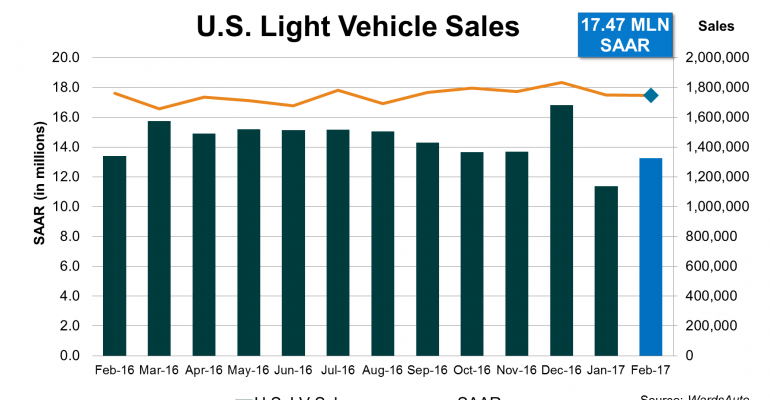Slower growth in incentive activity somewhat muted February’s U.S. light-vehicle sales, which still finished at a strong 17.5 million-unit seasonally adjusted annual rate, but fell below the 17.8 million SAAR averaged since last September.
However, incentives remain strong, and that’s the main reason sales have been tracking closer to an 18 million-unit SAAR than 17 million.
But, according to ALG, February’s 13.5% year-over-year increase in incentives was the smallest rise since August. Accordingly, except for January’s 17.4 million-unit SAAR, which was lower due to a major pull-ahead of volume into December, February’s SAAR also was the lowest since August.
February’s sales totaled 1.326 million units, 1.1% below like-2016 – 24 selling days both periods – and the second decline for the year. February 2016’s SAAR was 17.7 million.
An initial estimate for fleet penetration, based on publicly available data, indicates volume was relatively flat with year-ago. Thus, retail volume was below year-ago.
The most heated competition appeared to be in the Large Pickup segment. Sales increased 10.9% over year-ago – the biggest jump since July 2015 – and greatly benefited four of the five automakers in the segment.
Overall results for FCA and Ford would have been much worse than the declines of 10.4% and 4.1%, respectively, if not for fullsize pickups, while the segment drove General Motors and Nissan to gains, 4.1% and 3.7%, respectively, instead of losses. The outlier was the Toyota Tundra’s 12.9% shortfall, which exacerbated Toyota’s overall decline of 7.2%.
CUV deliveries increased 10.1% from year-ago, thanks to a whopping 16.7% gain in the Middle CUV segment, the biggest segment in the market. Interestingly, Small CUVs, a fast-growing and expanding segment, posted an 11.5% decline, its first since October 2012. The downturn followed a tepid 1% gain in January, at a time when inventory for the segment is getting bloated.
The Small Pickup, SUV and Large Van sectors also recorded increases in February, while the Small Van segment continued a precipitous slide that began in the latter part of 2016, declining 20.9%.
Overall, trucks increased 7.1% from same-month 2016, with penetration increasing to 63.5% from 58.6%.
Cars declined 12.8% from year-ago, and penetration dropped to 36.5% from 41.4% in February 2016. Sliding demand for cars hugely impacted most automakers, with the biggest declines recorded by the Top 4 in market share: GM’s car deliveries were down 22.7%; Ford, 24.0%; Toyota, 17.2%; and FCA, 24.0%.
Several automakers did buck the trend in cars, including Daimler, Jaguar Land Rover, Mitsubishi, Subaru, Tesla, Volkswagen Group and Volvo. Less those automakers, car deliveries fell 15.7%.
All car segment groups recorded declines, with Small Specialty and Middle Luxury the only segments to post gains.
Other automakers posting February gains included Daimler, Honda, Jaguar Land Rover, Mazda, Mitsubishi, Subaru, Tesla and Volkswagen. BMW, Kia and Volvo recorded declines.
Through the first two months of 2017, sales totaled 2.463 million units, 1.4% below year-ago. WardsAuto is forecasting 17.3 million for the entire year.





